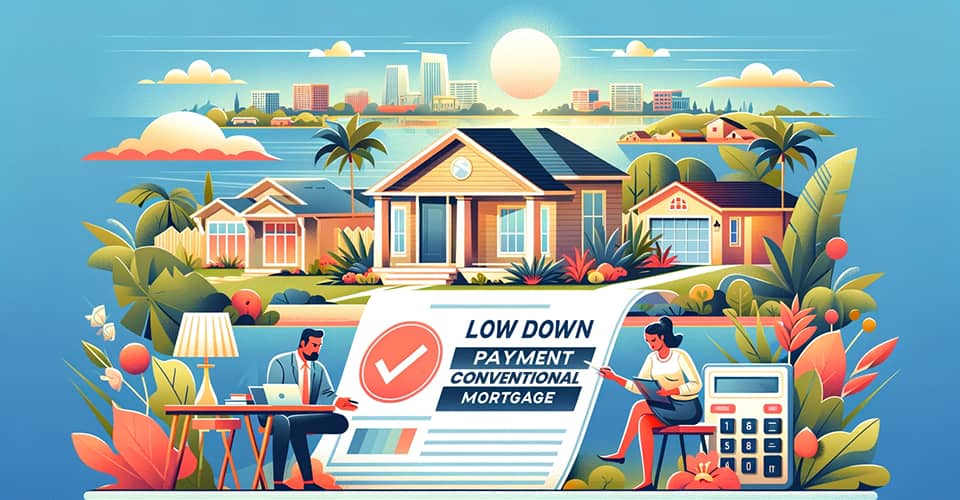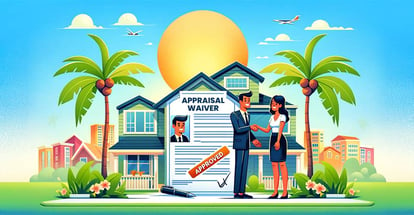Low Down Payment Conventional Mortgage Options in Florida: A Guide
We'll walk you through the various programs offered by Fannie Mae and Freddie Mac, highlight eligibility requirements, and detail the benefits of each.
This way, you can make an informed decision and move closer to purchasing your home with a smaller initial investment.
Conventional Low Down Payment Programs
Looking to buy a home with a small down payment? Fannie Mae and Freddie Mac have programs that can help. Below, we'll explore these options, showing you what's available and how they can make buying a home more accessible.
Fannie Mae HomeReady®
Fannie Mae's HomeReady® program is designed for buyers looking for low down payment options. It is available for purchase or limited cash-out refinance (LCOR) transactions.
This program supports 1-unit principal residences, including eligible condos, co-ops, PUDs, and manufactured housing. It also allows for 2- to 4-unit principal residences, though certain property types like condos, co-ops, or manufactured housing are excluded.
Key features include LTV limits up to 95%-97%, with conditions such as DU approval for the maximum LTV and specific considerations for manufactured homes.
Fannie Mae Standard 97
Like the HomeReady® program, the Fannie Mae Standard 97 loan offers financing options for purchases or LCOR with LTV ratios of 95%-97%. The program is aimed at properties, including 1-unit principal residences.
It supports various property types with restrictions and considerations similar to those of HomeReady®, particularly regarding LTV limits, DU approval requirements, and specific conditions for manufactured homes.
Freddie Mac HomeOne®
Freddie Mac's HomeOne® program focuses on the purchase, or no-cash-out refinance options, strongly emphasizing first-time homebuyers. It accommodates 1-unit principal residences, including PUDs and condos, but does not allow manufactured homes.
LTV limits for the HomeOne® program are also set at 95%—97%, with particular requirements for achieving the maximum LTV and specific conditions for refinances and manufactured homes.
Freddie Mac Home Possible®
The Home Possible® program from Freddie Mac provides flexible financing options for purchases or no-cash-out refinances. It is available for 1-4 unit principal residences, PUDs, condos, and manufactured homes, catering to a broader range of housing types than HomeOne®.
This program also features LTV limits of up to 95%-97%, with eligibility conditions including DU approval for maximum LTV and distinct guidelines for manufactured homes and other property types.

Types of Properties and Occupancies Eligible for Low Down Payment Financing Programs
When purchasing a home with a low down payment, Fannie Mae and Freddie Mac programs offer flexibility in the types of properties and occupancies they accommodate.
These programs generally cover a range of property types, including single-family homes, condos, planned unit developments (PUDs), co-operatives (co-ops), and even manufactured housing.
The options extend from 1-unit principal residences up to 4-unit principal residences, offering opportunities for buyers interested in multifamily properties or seeking to invest in a home plus income-generating units.
Specifically, both Fannie Mae's HomeReady® and Standard 97 programs and Freddie Mac's Home Possible® program provide broad eligibility criteria that include various housing types to suit different homebuyer needs.
While the Freddie Mac HomeOne® program is slightly more restrictive, focusing primarily on single-unit principal residences and excluding manufactured homes, it still plays a vital role in assisting first-time homebuyers.
Across these programs, the emphasis is on making homeownership more accessible, ensuring that buyers can find suitable financing options regardless of the type of property they are interested in purchasing.
Loan-to-Value (LTV) Limits and Requirements
The loan-to-value (LTV) ratio is a crucial metric in mortgage lending. It represents the percentage of a property's value financed through a loan.
Essentially, it measures the loan amount in relation to the property's appraised value or purchase price, whichever is lower.
A lower LTV ratio indicates more equity in the property, which is generally viewed more favorably by lenders as it implies less risk.
Fannie Mae HomeReady® and Standard 97
Fannie Mae's HomeReady® and Standard 97 programs allow for LTV ratios typically between 95% and 97%. For buyers to qualify for the maximum 97% LTV, Desktop Underwriter (DU) approval is required.
If the loan does not receive DU approval, it must be manually underwritten, and the maximum LTV is reduced to 95%.
Additionally, for the HomeReady® program, a limited cash-out refinance (LCOR) is available only if the current lien is an existing Fannie Mae loan for LTVs between 95.01% and 97%.
Freddie Mac HomeOne®
The HomeOne® program from Freddie Mac also supports LTV limits within the 95%-97% range for purchases and no-cash-out refinances.
Like Fannie Mae's offerings, achieving the upper limit of the LTV range may require specific approvals or conditions, emphasizing support for first-time homebuyers and streamlined refinancing options.
Freddie Mac Home Possible®
Freddie Mac's Home Possible® program offers LTV limits up to 95% for 2-unit properties and 3-4-unit properties, emphasizing providing flexible financing solutions.
For certain transactions, such as those involving manufactured homes or requiring secondary financing, the program allows LTV ratios to extend up to 105% Combined Loan-to-Value (CLTV) with eligible Community Seconds, indicating a broader scope for financing higher-value homes or those needing additional financial assistance.
FAQ: Low Down Payment Financing Programs
Understanding the low-down-payment financing options that Fannie Mae and Freddie Mac offer can be complex.
This FAQ section addresses some of the most common questions related to income limits, first-time homebuyer requirements, and other key aspects of these programs.
Are there income limits or requirements for borrowers under these programs?
Yes, programs like Fannie Mae's HomeReady® and Freddie Mac's Home Possible® set income limits for borrowers at 80% or less of the Area Median Income (AMI).
Conversely, other programs might not specify any income limits, offering more flexibility to applicants regardless of their income levels.
Is there a first-time homebuyer requirement for any of these programs?
Indeed, certain programs require at least one borrower to be a first-time homebuyer. Definitions of a first-time homebuyer vary but generally include individuals who have not owned a home in the past three years.
Can non-occupant co-borrowers be included in the loan application?
Including non-occupant co-borrowers is permissible under specific conditions, which may involve LTV adjustments and occupancy requirements. This option allows borrowers needing additional income support to qualify for a loan.
Are there specific provisions for manufactured housing under these programs?
Specific guidelines are provided for financing manufactured homes, distinguishing between MH Advantage homes and standard manufactured homes.
These provisions include varied LTV limits and other eligibility criteria to accommodate buyers interested in manufactured housing.
What are the options for renovation financing within these programs?
Renovation financing options, such as Fannie Mae's HomeStyle® Renovation and Freddie Mac's CHOICERenovation® programs, are available.
These options require lender approval and are designed to help borrowers finance the purchase of a home and the cost of improvements.
What are the temporary buydown options available?
Temporary buydowns, including 3-2-1 and 2-1 structures, are available for certain properties to help borrowers reduce their interest rates and monthly payments during the initial years of the loan. However, there are specific restrictions on manufactured homes regarding these buydowns.
What are the requirements for homeowner education courses under these programs?
Homeowner education courses are required for first-time homebuyers and under certain conditions within these programs.
At least one borrower must complete a course from a qualified provider to ensure they are well-informed about the homeownership process and responsibilities.
Bottom Line
Buying a home in Florida with a low down payment is more accessible than many might think, thanks to various programs from Fannie Mae and Freddie Mac.
Our guide has walked you through the essentials of these programs, from property types and occupancy requirements to LTV limits, income requirements, and more, all designed to make homeownership more attainable.
Whether you're a first-time buyer, interested in manufactured homes, or looking into renovation options, there's a path forward.
If you dream of owning a home in Florida but feel held back by the thought of a large down payment, there's good news. Contact MakeFloridaYourHome for personalized assistance and take the next step towards making your dream a reality.
With over 50 years of mortgage industry experience, we are here to help you achieve the American dream of owning a home. We strive to provide the best education before, during, and after you buy a home. Our advice is based on experience with Phil Ganz and Team closing over One billion dollars and helping countless families.

About Author - Phil Ganz
Phil Ganz has over 20+ years of experience in the residential financing space. With over a billion dollars of funded loans, Phil helps homebuyers configure the perfect mortgage plan. Whether it's your first home, a complex multiple-property purchase, or anything in between, Phil has the experience to help you achieve your goals.


 By
By  Edited by
Edited by 




